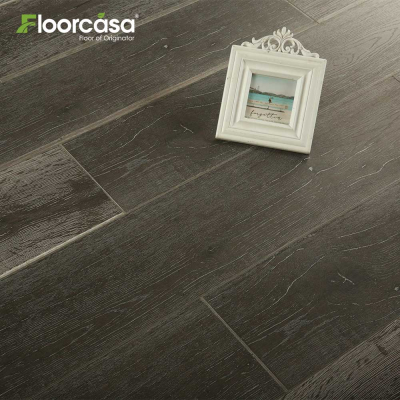SPC Flooring Pros and Cons
SPC Flooring Pros and Cons: A Technical, Standards-Based Guide
Introduction
Stone Plastic Composite (SPC) flooring has rapidly gained popularity across residential, commercial, and industrial sectors due to its unique structure, dimensional stability, and waterproof performance. However, like any engineered product, SPC flooring has distinct advantages and limitations that should be evaluated before installation.
This article provides a technical deep-dive into the pros and cons of SPC flooring, referencing material science, flooring engineering principles, regulatory compliance standards, and real-world performance metrics.
What Is SPC Flooring?
SPC flooring, or Stone Plastic Composite flooring, is a type of rigid core luxury vinyl plank (LVP) made from a combination of natural limestone powder, polyvinyl chloride (PVC), and stabilizers. Its layered construction includes:
UV Wear Layer: Protects from stains, scuffs, and abrasion.
Decor Film Layer: Mimics wood, stone, or ceramic designs.
SPC Core: High-density rigid core offering dimensional stability.
Underlayment (optional): EVA or IXPE foam for acoustic dampening and comfort.
Pros of SPC Flooring
1. 100% Waterproof
SPC’s core is fully waterproof, making it ideal for moisture-prone areas such as kitchens, bathrooms, laundry rooms, and basements.
Engineering Basis: The high limestone content (typically 60–70%) ensures hydrophobicity and structural rigidity under hydrostatic pressure.
2. Superior Dimensional Stability
Compared to WPC (Wood Plastic Composite) and traditional LVP, SPC has low thermal expansion coefficients, making it suitable for areas with temperature fluctuations.
Standard Reference: Meets or exceeds ASTM F3261 (standard for resilient flooring with rigid polymeric core).
3. Ease of Installation
Utilizes a click-lock system compatible with floating floor installations. Can be laid directly over concrete, tile, or old vinyl with minimal prep.
Tolerances: Allows for subfloor level variance up to 3mm over 2 meters.
4. Scratch and Dent Resistance
The rigid core and thick wear layer (usually 8–20 mil) offer improved performance in high-traffic areas and under heavy furniture.
Testing Standard: Scratch resistance rated via EN 660-2 and Taber Abrasion Test.
5. Fire and Slip Safety
Most SPC flooring products are certified with Bfl-s1 fire classification under EN 13501-1 and anti-slip ratings per ASTM D2047.
6. Low Maintenance
Does not require sealing, waxing, or specialized cleaners. A pH-neutral cleaner is sufficient for regular maintenance.
7. Acoustic Performance
SPC flooring with pre-attached underlayments achieves IIC ratings of 60–68 and STC ratings above 55, compliant with multifamily dwelling acoustic standards.
Cons of SPC Flooring
1. Cold and Hard Underfoot
Due to the high limestone content, SPC floors can feel colder and harder than WPC or cork-based alternatives.
Mitigation: Use of IXPE/EVA underlayment can slightly enhance comfort and insulation.
2. Limited Refinishing Options
Unlike solid hardwood, SPC cannot be sanded or refinished. Deep scratches or gouges may require plank replacement.
3. Subfloor Sensitivity
Although tolerant of minor imperfections, major subfloor leveling may still be necessary to avoid stress on joints over time.
Installation Standard: Compliant with ASTM F710 for subfloor preparation.
4. Environmental Impact
The PVC content in SPC makes it less eco-friendly than natural materials. Recycling options are limited, though some products meet FloorScore or GREENGUARD Gold indoor air quality certifications.
5. Acoustic Transfer Without Underlayment
Bare SPC flooring (without attached foam layers) may produce a hollow sound underfoot and increase impact noise.
Technical Comparison Table (SPC vs. Other Flooring)
| Feature | SPC Flooring | WPC Flooring | Laminate |
|---|---|---|---|
| Waterproof | Yes | Moderate | No |
| Dimensional Stability | High | Medium | Low |
| Installation Type | Click-Lock | Click-Lock | Click/Glue |
| Refinishing Capability | None | None | None |
| Fire Rating | Bfl-s1 (EU) | Bfl-s1 (EU) | Varies |
| VOC Emissions | Low (varies) | Low (varies) | Medium–High |
Frequently Asked Questions (FAQ)
Q1: Can SPC flooring be used in radiant heating systems?
A: Yes. SPC flooring is compatible with underfloor heating systems up to 27°C (80°F). Always check for manufacturer-specific temperature limits.
Q2: Is SPC flooring suitable for commercial applications?
A: Absolutely. Its high PSI resistance (250+ psi) and thick wear layers make it ideal for retail spaces, offices, and light industrial use.
Q3: Does SPC flooring off-gas VOCs?
A: Most high-quality SPC flooring complies with ISO 16000-9 or CA Section 01350 low-VOC standards. Look for FloorScore or GREENGUARD certifications.
Q4: Can it be installed in sunrooms or areas with direct sunlight?
A: Yes, though using UV-resistant coatings and maintaining expansion gaps is critical to avoid buckling from thermal expansion.
Installation Considerations and Best Practices
Ensure moisture level in concrete is <5% using the calcium carbide (CM) method
Install vapor barrier (min. 6 mil polyethylene) over slab
Acclimate flooring for at least 48 hours at ambient room temperature (18–29°C)
Maintain 5–10mm expansion gaps around perimeter
Avoid heavy rolling loads (>500 lbs) directly over click-joints
Conclusion: Is SPC Flooring Right for You?
SPC flooring offers a powerful combination of waterproof performance, stability, and durability, making it a strong contender for both residential and commercial spaces. However, careful consideration must be given to comfort levels, environmental footprint, and installation conditions.
For users seeking a robust, low-maintenance, and moisture-resistant flooring option that adheres to ASTM F3261, ISO 10582, and EN 13501-1, SPC is a technically sound and regulation-compliant choice.
Take the Next Step
If you're evaluating SPC flooring for your next project, we recommend consulting flooring specialists who can assist in material selection based on ASTM, EN, and ISO compliance. Reach out to our team of engineers and flooring consultants to receive personalized guidance tailored to your space, substrate conditions, and regulatory region.





